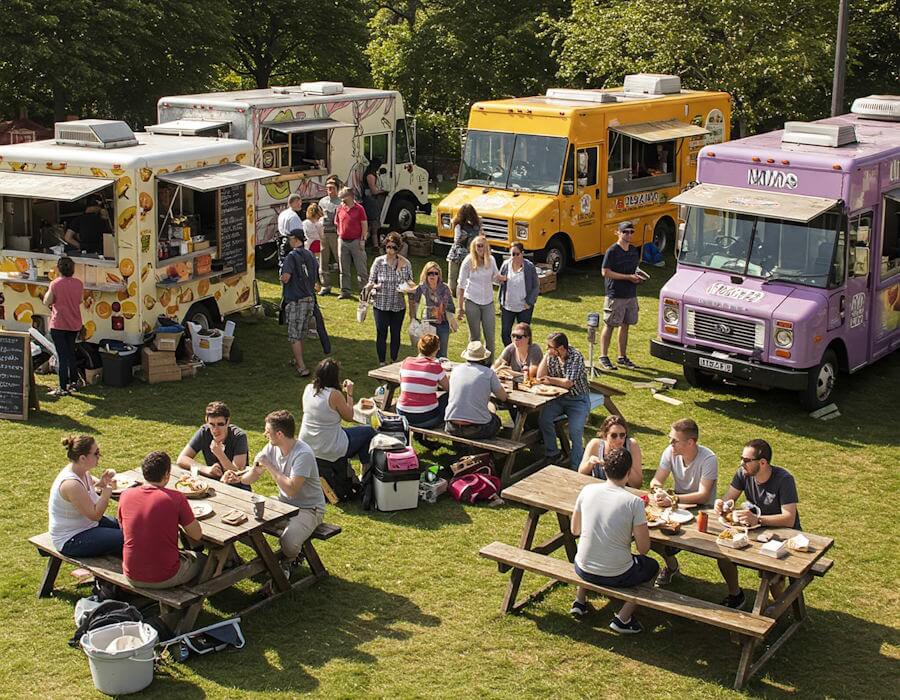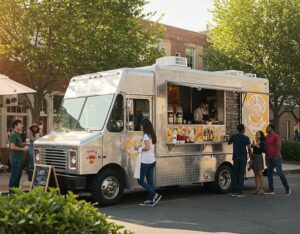Food trucks have emerged as a significant phenomenon within the realm of street dining, catering to a diverse populace eager for quick, affordable, and varied culinary experiences. Historically, the concept of mobile food service can be traced back to the 19th century with pushcarts and horse-drawn carriages, but the modern food truck began to take shape in the 2000s. This evolution reflects a transformation from a niche market aimed at festival-goers and late-night revelers to a thriving segment that has become an integral part of urban dining culture.
Today, food trucks are often synonymous with culinary innovation and entrepreneurial spirit. They provide seasoned chefs and aspiring cooks the opportunity to delve into the culinary world without the burden of establishing a traditional brick-and-mortar restaurant. These mobile eateries are versatile and adaptive, offering a wide range of cuisines—from gourmet burgers and artisanal tacos to vegan delicacies and international fare, catering to an array of dietary preferences.
The growing popularity of food trucks can be attributed to their ability to create a unique dining experience, often engaging customers through social media platforms and community events. They not only serve food but also foster a sense of community, bridging gaps between diverse cultures and promoting local ingredients. As cities continue to embrace urban dining trends, food trucks are set to become even more prevalent, reshaping our approach to casual eating and possibly influencing the future of the food service industry. Thus, they exemplify the dynamic interplay between consumer demand and culinary diversity in an increasingly fast-paced world.
The Rise of Street Food Culture
Across the globe, the culture of street food has witnessed significant growth, driven by various interconnected factors. One of the most notable influences is the globalization of culinary traditions. As cultures converge and exchange ideas, the concept of street food has evolved beyond traditional boundaries, bringing international flavors and cooking techniques to urban areas. This exchange fosters an environment where food trucks can thrive as they cater to an increasingly diverse clientele eager to try new gastronomic experiences.
Furthermore, there is a growing desire among consumers for unique and authentic culinary experiences. The modern diner values originality and craftsmanship, often seeking food that tells a story or reflects a specific cultural heritage. Food trucks have become synonymous with this quest for authenticity, as they often depict the personal stories and passions of the chefs behind them. Many food vendors prioritize sourcing local ingredients and creating dishes that highlight regional flavors, which appeals to consumers’ eagerness for genuine interactions with the people who produce their meals.
Additionally, the food truck industry benefits from the rise of social media, which has transformed the way people discover and engage with culinary offerings. Platforms like Instagram and TikTok allow food trucks to showcase their creations visually and interact with their audience directly. This fosters a sense of community and connection, making food trucks a popular choice not only for their cuisine but also for the experiences they provide. As people share their street dining adventures online, the visibility of food trucks continues to grow, leading to an enduring enthusiasm for street food culture worldwide.
Advantages of Food Trucks Over Traditional Restaurants
Food trucks have emerged as a prominent alternative to traditional brick-and-mortar restaurants, offering a range of advantages that appeal to both entrepreneurs and customers alike. One of the most significant benefits of food trucks is their lower operational costs. Unlike traditional restaurants, which require substantial investments in rent, utilities, and staffing, food trucks operate on a more manageable scale. This financial flexibility enables food truck owners to offer diverse menu options at competitive prices, attracting a broad customer base.
Additionally, food trucks enjoy unparalleled flexibility in their location. They are not confined to a single address, allowing them to adapt their operations based on foot traffic, special events, or local festivals. This mobility enhances the visibility and appeal of food trucks, as they can position themselves in strategic areas to reach their target customers more effectively. Such adaptability is a critical advantage, especially in urban areas where customer preferences may differ day by day.
The dynamic nature of food truck menus is another advantage they hold over traditional dining establishments. Food trucks often experiment with menu items, reflecting customer feedback and preferences in real-time. This responsiveness allows food truck operators to innovate and tailor their offerings to meet the evolving tastes of their clientele. As a result, customers often enjoy unique culinary experiences that can vary significantly based on the day or location.
Moreover, food trucks foster direct relationships with their customers. The informal setting and close contact facilitate personal interactions that are more difficult to achieve in a conventional restaurant environment. This sense of community helps build loyalty and enhances customer experiences, converting casual diners into dedicated patrons. The combination of lower costs, flexibility, a dynamic menu, and enhanced customer relationships positions food trucks as a compelling choice for the future of street dining.
Trend Toward Local and Sustainable Eating
The shift toward local and sustainable eating has become a defining trend in the food industry, with food trucks playing a pivotal role in this movement. As consumers increasingly seek out dining options that prioritize environmental responsibility and ethical sourcing, food trucks have emerged as champions of both local ingredients and sustainable practices. These mobile eateries often have closer ties to their communities, making them more accessible to local farmers and producers. As a result, many food trucks incorporate seasonal ingredients, offering dishes that reflect the region’s agricultural bounty while supporting the local economy.
Food trucks are inherently designed to be nimble and adaptable, allowing them to pivot their menus based on what is available and in season. This not only minimizes the carbon footprint associated with long-distance transportation of ingredients but also allows chefs to create unique culinary experiences that highlight the signature flavors of their locales. This approach resonates strongly with the growing cohort of eco-conscious consumers who prioritize sustainable dining. By opting for meals crafted from locally sourced produce, consumers contribute to a system that encourages local agriculture and reduces reliance on industrial farming practices.
Moreover, many food trucks adopt additional sustainable practices that further enhance their commitment to the planet. This includes the use of eco-friendly packaging materials, waste reduction strategies such as composting and recycling, and even alternative energy sources for their operations. Such practices not only help diminish their environmental footprint but also elevate the experience for patrons who value transparency and accountability in their food choices. The connection between food trucks, local sourcing, and sustainability exemplifies a larger societal shift toward mindful eating, making them a formidable presence in the evolving landscape of street dining.
Technological Integration in Food Trucks
The food truck industry has significantly evolved in recent years, primarily due to the integration of advanced technology. Mobile payment systems have emerged as a crucial component, allowing customers to pay conveniently through smartphones or contactless options. This not only enhances the customer experience but also streamlines operations for food truck vendors. By adopting mobile payment solutions, food trucks can reduce cash handling risks, speed up transaction times, and cater to a tech-savvy clientele that prefers quick and hassle-free transactions.
In addition to payment systems, social media marketing plays a pivotal role in promoting food trucks. Platforms such as Instagram, Twitter, and Facebook allow vendors to communicate directly with their audience, share daily locations, and showcase their unique culinary offerings. This direct engagement fosters a sense of community, encouraging repeat patronage. Many food trucks utilize social media to post menus, highlight special events, or even announce flash sales, attracting customers in real-time and driving foot traffic wherever they operate.
An essential technological aspect is the use of GPS tracking systems. These tools not only help food trucks determine optimal routes based on traffic conditions but also allow customers to track their favorite vendors in real-time. GPS systems enhance customer convenience by letting potential customers know the exact location of the food truck, thereby reducing wait times and improving service efficiency. This transparency fosters customer loyalty as consumers can easily access what they love most, leading to repeat business and greater satisfaction.
Overall, the integration of technology such as mobile payments, social media marketing, and GPS tracking has redefined the food truck industry. These advancements not only increase operational efficiency but also significantly enhance the customer experience, ensuring that food trucks remain a competitive and viable option in the realm of street dining.
Diverse Culinary Offerings and Global Influence
Food trucks have emerged as significant contributors to the landscape of street dining, offering a diverse array of culinary options that reflect both innovation and tradition. These mobile kitchens serve as platforms for chefs to showcase their creativity, presenting everything from fusion dishes that blend various culinary traditions to authentic representations of rich ethnic cuisines. The flexibility of food trucks allows chefs to experiment with ingredients and techniques, thus fostering a culture of culinary exploration.
The unique aspect of food trucks lies in their ability to respond rapidly to changing consumer tastes and preferences. This adaptability enables food truck chefs to introduce trending flavors and seasonal ingredients, enriching the street dining scene with diverse culinary offerings. Consequently, patrons can enjoy a wide range of options, including gourmet tacos, artisanal sandwiches, and vegan dishes that cater to all dietary needs. This wide-ranging selection promotes inclusivity in dining, welcoming individuals from various cultural backgrounds and gastronomic preferences.
Moreover, food trucks play a crucial role in cultural exchange. They provide a space where traditional recipes can be preserved and celebrated while also allowing for the inflection of new ideas and tastes. This merging of culinary practices fosters a sense of global connection, enabling food lovers to experience the culinary heritage of countries they may not be able to visit. As food trucks circulate through different neighborhoods, they bring cultural diversity directly to the community, contributing to a vibrant and dynamic food culture.
Overall, the influence of food trucks extends beyond mere meals; they are vehicles of cultural storytelling and innovation. By highlighting and celebrating diverse culinary traditions, food trucks play an essential role in shaping the future of street dining, making it not only a convenient dining choice but also a rich avenue for cultural exchange and gastronomic exploration.
Challenges Faced by Food Truck Operators
The food truck industry, while thriving and popular among consumers, confronts various challenges that can significantly impact its operations. One of the foremost hurdles facing food truck operators is navigating the complexities of zoning regulations. These regulations vary widely by city and sometimes even by neighborhoods, dictating where food trucks may park, operate, and serve customers. Operators often need to be well-versed in local laws and may require special permits or licenses, which can be time-consuming and costly to obtain. Failure to comply can result in hefty fines or being shut down entirely, adding stress to day-to-day operations.
Another critical aspect is adherence to health and safety compliance, which is essential to maintain consumer trust and ensure food quality. Each jurisdiction mandates specific health codes and regulations that food truck operators must follow, including food storage, preparation, and serving procedures. These requirements can vary significantly, and food truck owners must regularly update their knowledge to remain compliant. Regular inspections by health departments can lead to unexpected operational halts if violations are identified, making it critical for operators to prioritize maintaining high standards of hygiene and food safety.
Competition represents yet another challenge for food truck operators. With the rapid growth of this segment of the food industry, standing out among a saturated market can be difficult. New entrants continuously join the fray, offering diverse cuisines and innovative dining experiences. To combat this, successful food truck operators often employ strategic marketing tactics, leverage social media, and engage with their communities to build a loyal customer base. Differentiating their food offerings and consistently providing excellent service become essential strategies to sustain and grow their business in a competitive environment.
The Role of Community in Food Truck Success
The success of food trucks is closely intertwined with the communities in which they operate. Establishing a loyal customer base is paramount for food truck operators. Unlike traditional restaurants, food trucks often rely on repeat customers who not only enjoy their unique offerings but also help spread the word through personal recommendations. By building strong relationships with regular patrons, food truck owners can create a sense of belonging and attachment that is crucial for sustaining their business in competitive markets.
Participation in local events plays a significant role in enhancing a food truck’s visibility and popularity. Many food trucks thrive by engaging with community festivals, farmers’ markets, and fairs, where they can showcase their culinary talents. These events provide an opportunity for food truck owners to interact with potential customers and demonstrate their commitment to the local culture. By setting up at community gatherings, food trucks are not only promoting their cuisine but also contributing to the vibrancy of the local food scene.
Collaboration with other local businesses further strengthens the food truck’s relationship with the community. Partnering with nearby breweries, bakeries, or artisanal shops can create a mutually beneficial ecosystem. Such collaborations might involve organizing joint events or offering special promotions that bring together diverse culinary experiences. This network effect can enhance customer engagement, creating a win-win scenario for all businesses involved. As food trucks continue to evolve in response to consumer preferences, their integration within the community landscape will remain a vital factor in their longevity and success.
Future Trends in the Food Truck Industry
The food truck industry has experienced a remarkable evolution over the past decade, and it is poised for further transformation as we move forward. One of the notable influences shaping the future of food trucks is the impact of the pandemic. As public health concerns have altered dining behaviors, many consumers have gravitated toward outdoor dining options. Food trucks, with their mobility and flexibility, have become an ideal solution, allowing people to enjoy diverse cuisines while maintaining social distancing. This trend is likely to continue, as patrons increasingly appreciate the convenience and adaptability of mobile eateries.
Moreover, health-conscious dining has gained prominence in recent years, driven by a growing awareness of nutrition and wellness. As consumers shift towards healthier eating habits, food trucks are responding by incorporating fresh ingredients and creating dishes that cater to a range of dietary preferences, including vegan, gluten-free, and organic options. This emphasis on health will not only attract a broader audience but will also promote sustainability and environmental responsibility within the industry.
Additionally, the food truck sector is expected to expand into new markets and demographics. Urban areas will continue to be a stronghold for food trucks, yet there is an increasing opportunity in suburban and rural communities. As regions without access to diverse dining options see food trucks emerge, these mobile establishments can serve as a bridge, introducing global flavors into local markets.
Partnerships with local farmers and businesses will also be instrumental in shaping this industry’s future. Collaborating with nearby vendors can enhance menu offerings and promote a sense of community. Understanding and adapting to these evolving trends will be critical for food truck operators seeking to thrive in a competitive landscape.




